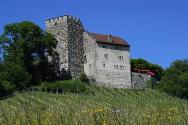What is an "alternative lifestyle"? Alternative lifestyle movement
Squatting in Russia is a phenomenon of the 80s. For those who haven’t seen it or don’t remember, there is a good film on this topic by Arthur Aristakisyan, “A Place on Earth,” where in the center of events is the story of a hippie commune, which considers it its duty to warm and caress the poor and disadvantaged. In Europe, squattering is a serious social problem.
Here's what Wikipedia says about it:
Squatting or squatting is the act of unauthorized settlement of an abandoned or unoccupied place or building by persons (squatters) who are not its legal owners or tenants, and who do not have other permission to use it.
Squat is an illegally occupied premises.
Squatters often claim rights to the sites they occupy based on actual occupancy rather than ownership; in this sense, squatting is similar to (and is potentially a necessary condition for) “negative” or “adverse” possession, whereby the actual owner of the property can obtain legal title to the property. In Russian legislation this is called “acquisitive prescription”.
“If a classic Western squat is a hangar or an old factory, with a naively painted facade and a flag on the roof, the inhabitants of which are certainly carriers of the corresponding ideology and are always ready to fight for their home with the municipal authorities - or even with the devil himself! - then the classic Russian squat This is a crowded residential building in the city center, the empty apartments of which are temporarily occupied by art workshops, music studios and simply bedrooms for “sympathizers”.
In Moscow, the era of squatting is already a thing of the past. Its first sign was “Kindergarten”; Then the time came for the famous “Furmanny”, a residential building in Furmanny Lane, where artists’ studios appeared already in 1987. It seems that the first to settle there were Amanita, Vadim Zakharov, Yuri Albert, Andrei Filippov who returned from the army; “World Champions”... However, the number of residents was constantly increasing, empty apartments one after another became workshops, and for artists who came to Moscow from other cities, apartments on Furmanny were permanent housing. Many decided to move to the capital only because there was a squat there on Furmanny: no good, but still a guarantee of a roof over their head." Max Frei
Today there are dozens of illegally occupied empty premises across Europe. They are populated not only by the homeless, but also by simply marginalized individuals, young people who have run away from home, and free artists. Many have a higher education or are receiving it. Many live in squats for generations. For example, there is a Rastafarian squat. Every story of an individual squatter is worthy of a novel. To be sure, Wim Wenders roughly described the squat in the film “The Million Dollar Hotel.” Maybe the room was unrealistically decent, but the same crazy people lived there.
In general, this is hippie culture. There are a lot of heart-warming details online about how squatters were evicted by riot police, how people lost the roof over their heads. In fact, our homeless people never dreamed of such a life, but most importantly, squats are in the rearguard of underground culture...
If you intend to find a squat, then most of them have their own website. Here are a couple of tips from one expert:
1. Good squats are located on the outskirts of the city, so start your search there.
2. It is best to go searching for friends.
3. Ask homeless people - they should know about local buildings.
4. If you find an abandoned building, first carefully inspect it for the presence of light and water, as well as syringes, tablets, etc. (being around drug addicts won't do you any good).
5. If you have neighbors, try to get to know them and find out as much information as possible about this squat.
I will not dwell on all the details of squatting, the lives of squatters and their problems... I’d rather give a specific example of one of the most famous centers - RampART.
RampART is a squatted social center in the Whitechapel area of east London. It was founded in an abandoned building on Rampart Street, which formerly housed a Muslim girls' school. The center is run as a private club, providing space for a wide range of groups. Like all such projects, it is run by volunteers without funding, is part of the D.I.Y. culture and, most importantly, all decisions there are made by consensus.
The center is known as the rampART Social Center, rampART Creative Center, Social Center, or more commonly, simply rampART.
RampART opened on 21 May 2004. It is located at 15-17 Rampart Street, London E1 2LA. The project was initiated by a mixture of artists, local community groups and political activists. Within its first year, the building hosted over 100 cultural and political events – rampART firmly established itself on London's activist map.
The center is run by an open team as an autonomous space. It is open to everyone on the basis of universal equality. The project is run entirely on a volunteer basis. The participants are not charity workers or social workers. The project is carried out in the spirit of cooperation, solidarity and mutual assistance. This is not a commercial project created for profit - on the contrary, the center receives daily donations from participants or earns money through various events, such as concerts, cafes or film screenings.
RampART's charter states:
RampART is managed collectively. Anyone can join or make suggestions for the center by attending one of the weekly meetings on Monday after 6:00 pm. We try to make all important decisions by consensus to avoid hierarchy and also because a decision is more likely to be implemented if it is made by consensus.
In general, an interesting detail: the building used to belong to a Muslim school for girls.
Current use and status:
To avoid noise from the street, the squatters created a garden on the roof, making the squat more attractive for people to get some fresh air and smoke one more cigarette. The roof area has been fenced off, but there is a danger that the noise coming from there may cause discontent among neighbors. For their own meetings, the squatters demolished the walls on the first floor, thus creating spacious rooms that could accommodate 50-60 people.
The communities serving the squat are typically non-local. They are politically motivated and active people. Hundreds of people have visited RampART, including 70 Bolivians who stayed here early last summer.
Here there are sambo groups, radical reading theorists, women's cafes, and movie lovers. The squatters have their own radio station. There is an opinion that messages are transmitted through such channels to attack the G8 summits.
In essence, squatters are homeless people, but excuse me, we would like to live like that. Squats attract many people who want to feel the spirit of anarchy; many tourists flock here - lovers of free housing.
What does the future hold for RamArt? They say that developers are buying up local land, and the squat will suffer the same fate as the rest. The residents will be evicted and the building will be demolished. True, in European countries squatters can only be evicted through the courts, which is not always observed
How to end up in this squat?
Meetings on Mondays
The rampART team meets every Monday evening at seven o'clock. This is the time and place where they discuss pressing issues and where events are organized. people receive feedback and plans are made for the future. If you are thinking of dressing up, it is better to send a message by email in advance. Rest assured it will be read
We include in this direction associations that seek to support an alternative environmentally oriented lifestyle at the place of residence, at the level of households and settlements. Some associations are focused on the revival of elements of traditional Russian culture in new conditions (the settlements “Nevo-Ekovil”, “Rysovo”). Others are largely inspired by the experiences of Western ecovillages and alternative lifestyle groups (ecogroups). It is not surprising that it is difficult to find a breeding environment for such associations in Russia. Community-based environmental associations appeared in the St. Petersburg region only in the mid-1990s and actively rely on international support. We believe that to some extent, the breeding environment for such groups was Western environmental movements and international support funds, whose residents landed troops of experts and activists in St. Petersburg. Let us give several examples of such associations.
One of them is the Ecogroup movement, which has been operating in the city since 1997. This movement was initiated during the implementation of the international project “Ecogroup” within the framework of the international public organization “Global Action Plan” (“GAP”), with funds from “TACIS”. “Ecogroups” is a program whose goal is “to help ordinary people contribute to solving environmental problems through conscious changes in lifestyle and attitude towards the environment.” The main tasks of “Ecogroup” are “greening” the home, developing an environmentally balanced household, saving energy, and sorting waste.
In this context, eco-groups are understood as small groups of people, most often neighboring or related communities (sometimes several neighboring families). Together with trainers from the TACIS program, representatives of eco-groups, firstly, analyze, and secondly, change their lifestyle, regulating the consumption of natural resources in the household in accordance with the calculations.
Another example is the St. Petersburg “Urban Gardening Club”. This neighborhood association implements the “Vegetable Garden on the Roof” program, which began in 1993. Program participants implement an eco-project at the level of a housing construction cooperative. The collective decision to participate in the program was made at a meeting of a housing cooperative in the Moskovsky district of St. Petersburg. Members of the cooperative became participants in the international Ecohome program.
The essence of the project is as follows. Vegetables have been grown on the roof of a residential building for six years: beets, carrots, cabbage, zucchini, cucumbers, tomatoes, peppers, peas, beans, and herbs. The Roof Garden is both a family support project and an environmental project.
Another option for associations focused on alternative lifestyles is ecovillages. There are currently three eco-villages in the Leningrad region: “Nevo-Ekovil”, “Ecological Village Rysovo” and the public association “International Center of Light in Grishino”. The idea of ecovillages is to create opportunities for an alternative lifestyle to the modern industrial city. The construction of eco-villages is considered as a “model of sustainable development of human settlements” (Reference book... 1998). Residents of ecovillages not only support an alternative (natural) way of life, but also disseminate their experience. They organize summer environmental camps for children and adults, conduct seminars on new land use technologies, organic farming and recycling of household waste.
Based on their composition, ecovillages can be called “villages of the intelligentsia.” They are often created by people with higher education who are disillusioned with the urban industrial lifestyle. Ecovillages can be considered an escape from urbanization, a cultural protest. For example, when talking about the motives for creating the Nevo-Ekovil settlement, its leader notes the following: the desire to change the urban way of life, the focus on creating a community that professes the ideas of Eastern philosophy, the desire to realize one’s way of life. Here is a fragment from his article.
“The idea of changing the urban way of life, full of social conventions, closed artificial spaces, divorced from the natural environment, came to us - a group of young guys who graduated from college and worked in ordinary Soviet institutions - back in 1985. Passion for Eastern philosophy, especially Agni Yoga, determined the form of embodiment of this idea as a community. Having chosen a place on the Karelian Isthmus in the Leningrad region, we began to implement our way of living. And it included: the construction of a large house for three families, designed for a communal lifestyle, with a large plot for a garden and vegetable garden, and the creation of a children’s art school with an arts and crafts focus, where we could work, developing the creative consciousness of children” (From articles by the head of the Nevo-Ekovil program).
The Nevo-Ekovil settlement, founded in 1994, is legally registered as a public organization with the same name. This status makes it possible to legally provide the ecovillage with the necessary resources - the organization has its own office, a plot of land, and operates several industries that support the program: architectural and construction workshops and a nursery. Projects on eco-tourism, environmental education, fish farming, and trade are being developed in the eco-village. In 1995, Nevo-Ekovil received funding from the Danish Gaia Trust, which supports a network of ecovillages around the world. Currently, “Nevo-Ekovil” is a member of the global network of ecovillages. Internet site http://www.cei.ru, Zdravomyslova E. “Ecological movement in Russia”
Many, perhaps, wanted to at least once abandon the lifestyle that modern society imposes and live differently. Everyone’s desires are different: some want to work less, while others want to communicate more with like-minded people or do something socially significant. It turns out that for those who want to give up everything and start from scratch, there are many ways to change their lives.
1. Ashram, temple and commune

Hindu ashrams are known to offer a quiet, contemplative life as well as participation in healthy, active community work. There is often no need for any money to participate, since the individual is expected to be able to help with the affairs of the ashram or temple, be an active member of the community, and be able to get along well with others.
If a person has a small donation to give at the beginning of their stay in a place like this, their contribution will help offset the costs of the community and help solidify their place in the community. Buddhist and some Sufi temples offer a similar lifestyle. Modern Christian monasteries often allow you to live in complete silence and solitude, which can be very useful if you want to “get away from everything worldly.”
2. Family "Rainbow"

The Rainbow Family is a loose association of hippie societies whose roots date back to the 1960s and 1970s. Many people of all ages maintained the ideal hippie lifestyle, traveling from place to place, forming regional gatherings, and living outside of mainstream society. Some of these societies have permanent camps or are located in specific cities, while others are purely nomadic. Barter is the main means of obtaining necessary goods.
Being a hippie means having a lot of adventures, listening to old stories about the counterculture, singing great songs around the fire, hiding from the weather and storms in makeshift huts and trying to live without comforts. If cleanliness and neatness are something a person cannot imagine himself without, then he may get tired of this very open lifestyle. But for those who like to dance half naked around a big fire to the sound of drums, this is just the thing.
3. Retreat center

There are many educational retreat centers in the US and abroad where people can go for a week or a weekend to practice self-help, learn to meditate, do art, dance, etc. Although these are commercial operations offering programs, there are generally There is an opportunity to live if you help the staff yourself.
Staying at a retreat camp must either be paid for or you must work (helping with cleaning, growing plants, or running events). This is one of the best ways to try to live differently and learn a lot of new things.
4. Organic farm

The next item is suitable for those who like to work with their hands. Organic sustainable farms around the world often require skilled and unskilled physical labor, especially during growing and harvesting periods. If a person has farming or gardening skills, then such a farm will be the best choice for him.
If the farm is large enough, its owners will gladly take on anyone who wants to work hard and learn quickly. Living on a farm is a leisurely way to get out of the normal daily routine. Working on a farm (although it will be hard work) should be enough to offset any rent and food costs, and if you contribute enough to the work, you may even be able to get a paid position.
5. Yoga center

Yoga centers are places where the public gathers to practice yoga and where one can enroll for an extended period of training. They generally practice an enjoyable, balanced lifestyle and a balanced combination of physical activity and relaxation. There is also an opportunity to meet many interesting people here. Typically, the cost of living in such a place will be significant, but it will be a great time, especially for those who practice yoga.
6. Life of a qualified specialist

There are skills that may be essential to many communities and organizations. If a person enjoys what they do, they can find ways to do it in a variety of settings, traveling and meeting new people in the process. For example, carpentry is a skill that is in high demand wherever new centers or buildings are being built.
If a person manages to prove his integrity to the foreman, he is often allowed to live at the construction site and is also fed. If a person is an excellent massage therapist, then there are many places where he can open a salon in exchange for free room and board (for example, the same retreat centers, communities and resorts, where they can even pay for work).
7. Co-op

Cooperatives are groups of people who pool resources to share needed goods and services such as food, housing, healthcare, etc. Cooperative housing provides a sense of community while allowing living in a city or urban area. Co-ops share tasks such as cleaning and shopping, and often rotate cooking and meal responsibilities.
Dining here is common, although co-op members typically have more varied individual schedules and activities than living in a commune, and co-op members often attend to personal matters. Co-ops are a great way to cut costs and live with a sense of community.
8. Permaculture

This is the mother of all alternative lifestyles! There are communities for everyone, you just need to choose one that suits your interests. Either way, joining a dedicated community can quickly change anyone's life. Communities can focus on permaculture, religion, nudity, off-grid living, survival skills, and many variations of counterculture beliefs.
9. Primitive Village

Primitive villages provide an unparalleled cultural experience. If anyone doesn’t understand, they live in them exactly the same as centuries ago. They cut down trees, fetch water from wells, make flour themselves, and make fire. They also don’t rush anywhere, talk slowly, look at the stars in the sky - everything that is so lacking in modern cities. Fishing, hunting and cooking take up most of the day. Also, a lot of time is devoted to spending time together, learning, telling stories, playing with children
10. Abroad

Of course, this is not an easy decision to make. As they say, it’s good where we are not. So why not be in Buenos Aires. If you go abroad, you can experience inexpensive living with a completely different style compared to what everyone is used to.
Particularly popular are Malaysia, Indonesia, Berlin, Central America, as well as a number of places in Mexico and South America. In some places you can find expat communities if you want to be around others who share a similar culture and language. In other cases, you will have to get used to the local culture.
More than once I asked myself this question and heard it from the lips of those who communicate with us on the topic of moving and living outside the city. And now it has become important for me to figure it out and determine what kind of alternative this is and to what? First I’ll answer with an article, and maybe we’ll devote the winter to a book;)
I think that much of what our family does is “different” and not similar to what “ordinary” modern urban families can imagine. The very fact that we live not in a city, but in a forest, far from a large city, outrages the usual understanding of modern life in our minds - “There are no people there? And everything you need? This is followed by the second most important question of concern - “What is it like there in the forest without money and all the benefits of civilization?”, and then the next one, “How will a child grow up there as a normal person, and not as a savage?” and so on. That is, everything you ask causes indignation. And why?
Alternative is different, in some ways opposite, and in some ways essentially different and not similar to what exists. And in some ways special and unique. A way of life is a foundation, order, essence, patterns, everything that determines the form and content. THAT is what a person “breathes” and how he manifests himself.
Our family moved towards an alternative lifestyle while still in an urban environment. Gradually and uncertainly. We began to think about how we live when we felt that we were deficient in nutrition, health, and self-expression. Are we limited by frames that we don’t even know where they came from or by whom? And we decided to figure it all out, starting with ourselves.
We became deeply interested in the topic of self-development, and attended a number of seminars on fasting, personal history, fears, breathing and general strengthening. We began to try ourselves in various social and business projects in order to find our creative “I”.
All these attempts led us to the realization that our life itself should become one that develops will and aspirations. And we have chosen for ourselves a vector in which we can realize our potential, going through difficulties and discovering new qualities for ourselves.
We definitely decided that life should be as close as possible to natural conditions, subject to the rhythms of COMMON LIFE. And they moved outside the city to the village.
This act was the first step on our part towards an alternative way of life. Because by changing our environment, we got the opportunity to look at everything that is happening from the other side, to expand our borders.
Then we began to master and practice for a long time ways and methods that formed our survival and adaptation skills in new conditions. Which also greatly expanded our perception of the world around us and our knowledge of it.
We immersed ourselves in the study and research of the following issues: - family and interpersonal relationships, as well as how important it is to develop them and maintain them, to establish or destroy unnecessary connections. - natural nutrition (vegetarianism, veganism, raw food diet, fruitarianism, pranaedeniya) and related crises, what are their causes? - development and upbringing of children, what is it based on, how is it better, more interesting, easier to arrange? - attachments and dependencies, fears, beliefs, convictions, thoughts and feelings. How does all this hinder or help us live? How to work with everything, what to do, what to accept, and what to ruthlessly reject? - MONEY and again MONEY. Where, how, how much and for what? Do we need them or will we abandon them forever? How to survive without money, or better yet, not to survive, but to live with dignity as a person? - Boredom, social unfulfillment. What is this and why are we afraid to be alone, alone with ourselves? What lies behind your own inferiority? Why do we run away to cities and an independent, self-sufficient life looks so scary?
This is a small series of questions, some of which we have already found answers to for ourselves, and some are still being revealed in a special way.
We have considerable experience behind us in unusual actions and decisions. We described a lot in the articles and shared our findings. And a lot remains sealed for now, because not everyone will be able to understand what I would like to say. To do this, as the wisdom of centuries says, “You need to sit at the same table and slurp the same porridge.” In other words, to be in a habitat like mine and live through those periods that form a different (alternative) way of seeing.
We often invite people to try the alternative on themselves, BUT few people decide to do this. Like in the movie The Matrix, Morpheus says to Neo - “I can only show the door, and it’s up to you to enter it or stay where you are.”
People tend to be afraid, make mistakes and be misled. But we still want to know the truth! And the most stubborn and persistent get to the bottom of the truth. In its depth it is simple and obvious. But we don’t notice it and often simply deliberately refuse to see it, because the illusion is tastier and more pleasant, brighter, more accessible.
Likewise, we act amateurishly with our own lives. We put it in the hands of those who, in our opinion, are more confident. And not everyone decides to make their reality different, alternative, not like everyone else. Because behind this lies RESPONSIBILITY + acceptance of your whole self, guts and torn pants.
It has now become the norm to live in big cities and eat from markets. And a simple alternative to this could even be buying a summer house!
Now, an alternative to everything that moves in the flow of mass agony of consumption can be any action that goes beyond the scope of this flow.
Stop dressing fashionably and you are already an alternative. Stop watching TV and you are again out of the flow of society, as if you were turned off. Stop feeding “LIKE EVERYONE else” and you will be cursed and scolded, you will bear the cross of the alternative;)
And so you become an outcast, first to everyone around you, and then to yourself. You understand that you are no longer within the framework of the life that the majority creates. And to start living your life, you should look for an alternative. Find and accept your choice and your life. Create your own alternative lifestyle! Because arguing with the system and defending your rights is always a defeat. Because, alternative lifestyle is defined as the ability to correspond (to be adequate) to circumstances based on individual choice and the search for solutions to certain life problems.
- When neither fear, nor delusions and beliefs cloud your eyes, and your approach to life is determined to act right now, without delaying until later.
- When you don’t compare yourself and your decisions with others, but check them with personal experience.
- When the essence of your life is clear only to you, and its image is clear and obvious to everyone.
An alternative lifestyle will always be the opposite of the prevailing social opinion, since it is based on the individual choice of a person. At the same time, the truth of a person’s individual choice is checked by the correspondence of his words and actions. If a person says one thing, but lives completely differently, his choice is distorted by internal contradictory attitudes. And the alternative for such a person would be to understand these contradictions in order to eliminate them.
When choosing an alternative lifestyle, a person is guided by common sense, and also takes into account his capabilities at the moment here and now and his intentions for the future.
Today, many people by alternative lifestyle mean living outside the city, a vegetarian diet, a healthy lifestyle, as well as a rejection of the technical benefits of civilization. But this is not quite as simple as one might see from the outside. As mentioned above, the essence of an alternative lifestyle is clear to those who choose it, but its image seems simple and obvious. So the essence is much deeper - it affects not only the sphere of nutrition and living environment, but the entire worldview of a person, his relationships with himself and other people, his attitude towards the environment (often more caring than that of a person with a social orientation, rather than an individual one!), life attitudes, attitude towards the world as a whole. And, as a rule, when choosing an alternative lifestyle, the essence is as close as possible to the truth of life! Because how a person understands himself and his significance is when he pays attention to himself as an individual and his peculiarity within the framework of the world, and not in particular, society. As such, as he is, a person is good only in natural (natural) conditions, in them he finds the meaning of being, as well as his significance. When a person falls into the bonds of social relationships (social games), a game automatically begins according to the rules of this society, which often goes against the individual intentions and life principles of the person.
That’s why it’s so important, when you choose an alternative for yourself today, to realize where you are and with whom you are now. If you are surrounded by hundreds and thousands of people whom you do not know personally, and they tell you how to live, you should think about whose life you are living and whose image you support? And when you find out the answer to this question, look for an alternative! She will always be individual and far from most opinions. To hear the answers you need, you should turn to nature. She does not impose opinions and beliefs, she gives rest and over time comes the awareness of her true alternative choice and lifestyle. But this takes time! And this time is a testing period that not everyone survives. Someone avoids being adequate to circumstances, someone does not believe in their capabilities, and someone is disappointed in everything! The alternative world is not as alluring and fragrant as society offers us. That’s why it’s so easy to leave him and go back to everyone else. But if you intend to find your own path, you can do anything. And even stay in the lifestyle that you choose for yourself! And then, brightly reflect it into the world with a special facet;)







